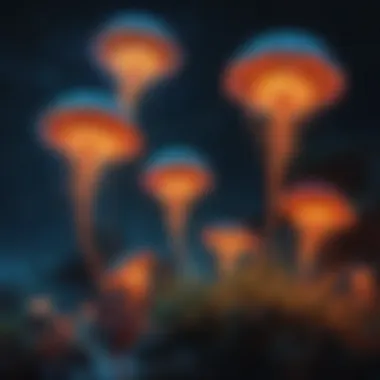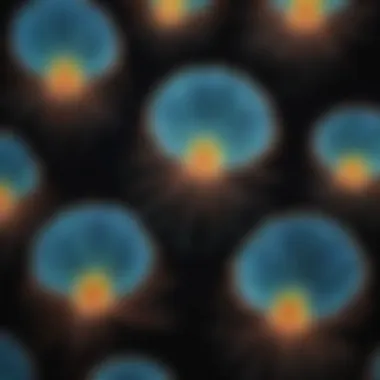The Enigma of Bioluminescent Dinoflagellates


Intro
Bioluminescent dinoflagellates are fascinating organisms that can illuminate the dark waters of oceans and seas. These tiny creatures engage in a kind of light show that captures the interest of many. But, what does it mean for an organism to be bioluminescent? In this article, we will explore the unique characteristics of dinoflagellates, how they produce light, and why their existence is so important in our ecosystems.
Understanding these organisms opens up new avenues for learning about marine life, which can intrigue both young students and curious minds alike. Let’s delve into their science, fun facts, and much more!
Science Fun Facts
Dinoflagellates have many surprising traits that make them unique among marine organisms. Here are some interesting facts to ponder:
- Light Production: The light produced by dinoflagellates can be blue or green. This is because of different chemicals that exist in these organisms.
- Ecological Interactions: Their bioluminescence serves as a defense mechanism. When disturbed, they emit light which repels some predators and attracts others.
- Size and Shape: Most dinoflagellates are between 20 to 2,000 micrometers in size. Despite their small size, they play massive roles in marine ecosystems.
- Research Opportunities: Scientists study bioluminescent dinoflagellates to understand their role in food webs and carbon cycles in oceans.
Here’s a question to think about: What could happen to marine life if dinoflagellates suddenly disappeared? Their disappearance may lead to significant changes in marine ecosystems.
Discover the Wonders of Science
The study of bioluminescent dinoflagellates not only enhances our knowledge of biology but also provides insight into marine science. Here are several ways to explore these concepts:
- Educational Videos and Animations: Visual resources can show how bioluminescence works at a cellular level. Websites like Britannica and Wikipedia offer extensive articles and videos.
- Interactive Learning Tools: Engaging activities and games can stimulate interest in marine science topics, especially among younger audiences.
- Real-Life Applications: Discovering how luminescent proteins from dinoflagellates are used in research can lead to advancements in various fields, like medicine.
Science Quiz Time
To test your knowledge about dinoflagellates, let’s try a few questions:
- What color can the light emitted by dinoflagellates be?
- Why do dinoflagellates emit light?
- A. Red
- B. Blue
- C. Green
- D. All of the above
- A. To attract mates
- B. To scare off predators
- C. As a way to find food
- D. To communicate with each other
These questions encourage learning through gamification.
Science Experiment Showcase
Try a simple experiment at home to see bioluminescence in action:
Materials Needed:
- A container of saltwater
- A small amount of bioluminescent dinoflagellates (can be purchased online)
- A dark room
Instructions:
- Add the bioluminescent dinoflagellates to the saltwater container.
- Gently stir the water to stimulate the dinoflagellates.
- Turn off all lights and observe!
Safety Tips:
- Always handle materials carefully.
- Ensure children are supervised during the experiment.
This interactive science activity introduces young learners to the mysterious world of dinoflagellates and their light-emitting capabilities.
Epilogue
Understanding bioluminescent dinoflagellates goes beyond appreciating their glow. It involves recognizing their significance in marine ecosystems and the overall health of oceans. By fostering curiosity in this subject, we can inspire future generations to explore and protect our delicate marine environments.
Prelims to Bioluminescent Dinoflagellates
Bioluminescent dinoflagellates are fascinating organisms that play a significant role in the marine environment. They are known for their unique ability to produce light, a feature that captures the curiosity of scientists and nature enthusiasts alike. Understanding these creatures helps shed light on the complex interactions within marine ecosystems. This article delves into various aspects of bioluminescent dinoflagellates, assessing their biological mechanisms, ecological significance, and the habitats they inhabit.
Understanding Bioluminescence


Bioluminescence is the production of light by living organisms. It serves different purposes including communication, camouflage, and attracting mates or prey. In dinoflagellates, this light emission is commonly triggered by physical disturbances in the water. When these organisms are agitated, they emit light, creating a beautiful glow in the water. This phenomenon is not just visually stunning; it also serves critical functions such as deterring predators and warning off potential threats.
What are Dinoflagellates?
Dinoflagellates are a group of single-celled organisms primarily found in marine environments. They are classified under the phylum Dinoflagellata and exhibit unique characteristics. Most dinoflagellates have two flagella allowing them to move freely in the water. Some can photosynthesize due to the presence of chlorophyll, while others are heterotrophic, obtaining nutrients by consuming organic matter. Their diversity extends to various shapes, sizes, and colors, making them an intriguing subject for study. Notably, dinoflagellates can form blooms under favorable conditions, leading to dense population increases that can impact local ecosystems. Understanding these organisms is crucial for marine biology as they are integral to food webs and nutrient cycling.
Biological Mechanisms of Light Emission
Understanding the biological mechanisms behind light emission in dinoflagellates is crucial. This section emphasizes how these mechanisms work, serving both ecological and biological roles. The ability to produce light is not just a fascinating spectacle. It also has benefits for survival and interaction with the environment.
Chemistry of Bioluminescence
Bioluminescence in dinoflagellates is a complex chemical process. It involves specific compounds and reactions. At its core, bioluminescence is a chemical reaction that produces light without heat. This process primarily involves two key components: luciferin and luciferase.
Luciferin is a light-emitting molecule. It undergoes oxidation in the presence of oxygen, resulting in an excited state that releases energy in the form of light as it returns to its ground state. Luciferase is the enzyme that catalyzes this reaction. It speeds up the process, making it efficient. To put it simply, without luciferin and luciferase, the beautiful glow of the ocean would not exist.
The Role of Luciferin and Luciferase
Luciferin and luciferase have pivotal roles in producing light. Each dinoflagellate species can produce different types of luciferin, leading to variations in emitted light color. This diversity is crucial, as it allows for different ecological functions.
- Luciferin Sources: Different types of dinoflagellates have distinct luciferins. This variety causes differences in color and intensity of the light produced.
- Luciferase Functionality: The luciferase enzyme varies between species. This variation also affects light characteristics. Some species can emit intense bursts of light, while others shine gently.
Together, these two components create the visual wonders of bioluminescence that can be observed in oceans around the world.
Cellular Processes Involved
Cellular processes also play a vital role in enabling bioluminescence. Dinoflagellates possess specialized organelles for bioluminescence. These organelles store the necessary chemicals for the light-producing reaction. When disturbed, certain cellular signals trigger these organelles.
The process starts with a stimulus. This can be anything from predator movement to changes in pressure. The dinoflagellate responds quickly, facilitating the release of luciferin and activating the luciferase enzyme. The result is a dazzling light show, serving as a defense mechanism or a means to attract prey.
To summarize, the biological mechanisms of light emission in bioluminescent dinoflagellates combine chemistry, specialized proteins, and cellular responses. These mechanisms enable them to thrive. Understanding these processes contributes to our broader knowledge of marine ecosystems and their inhabitants.
"Bioluminescence is not just a phenomenon but a vital ecological interaction that has captivated scientists for generations."
This knowledge ultimately enriches the appreciation of marine life, illustrating the sophistication of these tiny organisms.
Ecological Significance
Bioluminescent dinoflagellates play a crucial role in their ecosystems. They are not just fascinating organisms; they embody the intricate interactions within marine environments. These single-celled organisms contribute to the productivity of oceans, making them vital to marine food webs. Understanding their ecological significance helps us grasp broader environmental issues.
Role in Marine Ecosystems
Bioluminescent dinoflagellates serve as primary producers in the ocean. They convert sunlight into energy, forming the foundation for many marine food chains. When these organisms bloom, they can create spectacular displays in coastal waters, but this is just one aspect of their importance.
- Oxygen Production: Like other phytoplankton, dinoflagellates produce oxygen during photosynthesis, contributing to the overall oxygen levels in the ocean. This process is essential for many marine organisms.
- Food Source: They are a primary food source for various marine animals. Zooplankton, for instance, consume dinoflagellates, which are then eaten by larger fish and other marine creatures, illustrating their role in sustaining marine biodiversity.
- Nutrient Cycling: Through their life processes, dinoflagellates help cycle nutrients in the ocean. They absorb nutrients from their environment and release them back into the ecosystem, supporting other marine life.
Interactions with Other Marine Life
Dinoflagellates do not exist in isolation. They interact with a range of other marine organisms, creating a web of relationships essential to ocean health.
- Mutualism: In coral reefs, some dinoflagellates establish symbiotic relationships with corals. They provide energy through photosynthesis while benefiting from the coral's protection and nutrient-rich habitat.
- Predation: Many marine species depend on dinoflagellates for food. For example, copepods feed on these organisms, allowing energy to flow up the food chain.
- Toxicity: Some bioluminescent dinoflagellates can produce toxins that affect fish and other marine life. This factor stresses the complexity of their roles, highlighting how they can both nourish and harm depending on the environmental context.
"Understanding bioluminescent dinoflagellates is essential for grasping the dynamics of marine ecosystems. They are more than just light sources; they are integral players in ocean health."
In summary, the ecological significance of bioluminescent dinoflagellates is profound. Their interactions with other marine life and essential contributions to marine ecosystems underscore their importance. It is necessary to protect these remarkable organisms and the environments they inhabit.
Habitat of Bioluminescent Dinoflagellates
The habitat of bioluminescent dinoflagellates is a topic of great importance in understanding their life and ecological roles. These microorganisms tend to thrive in specific environments that fulfill their needs for light, nutrients, and stability. Their unique ability to emit light makes them a fascinating study for both scientists and enthusiasts.


Preferred Environments
Bioluminescent dinoflagellates prefer environments that are rich in nutrients, often found in coastal areas. They are commonly found in:
- Shallow coastal waters
- Estuaries
- Mangroves
- Coral reefs
These habitats provide the right combination of light and nutrients, allowing dinoflagellates to flourish.
The presence of organic material in these waters encourages the growth of dinoflagellates. The shallow waters also ensure that sunlight reaches them, which is essential for photosynthesis. Some species can even thrive in both marine and brackish environments.
Global Distribution
Bioluminescent dinoflagellates are widely distributed around the globe. They can be found in:
- Tropical regions: Where warm waters help them thrive
- Temperate waters: In various coastal locales
- Some Arctic areas: Certain species are adapted to cold water
This wide distribution indicates their adaptability to different marine conditions. However, they are more commonly seen in coastal regions where nutrient levels are higher.
The distribution of bioluminescent dinoflagellates signifies their ecological flexibility and the importance of healthy marine environments.
Understanding their habitat is essential for their conservation and the overall health of marine ecosystems.
Phenomena of Bioluminescence in Nature
Bioluminescence is a remarkable natural phenomenon that captures the imagination of many. It involves the production of light by living organisms, specifically dinoflagellates in our case. These creatures light up in various situations, resulting in stunning displays in oceans. Understanding this phenomenon's depths enhances appreciation for marine biology and showcases the beauty of nature.
Illuminated Shores and the Sea
One significant presentation of bioluminescence occurs along coastlines, where waves crash against the shore. This results in glowing waters, often seen during certain seasons. The light emitted by dinoflagellates can be striking, creating a surreal experience. This shimmering effect may appear in shades of blue or green, captivating those who encounter it.
The glowing waves typically occur in regions with high concentrations of bioluminescent dinoflagellates. One famous area for this spectacle is Mosquito Bay in Vieques, Puerto Rico. Visitors often describe the waters as a magical experience as they swim or paddle through the vibrant blue glow. These illuminated shores are not only beautiful; they also indicate healthy marine ecosystems.
Many individuals engage with these locations, which enhances awareness and encourages conservation efforts. Protecting the habitats of bioluminescent dinoflagellates ensures future generations can witness such awe-inspiring natural events.
Here are some factors contributing to these illuminated shores:
- Water Movement: Wave action helps agitate the dinoflagellates, triggering their glowing response.
- Nutrient Availability: Areas with plentiful nutrients support large populations of these microorganisms.
- Weather Conditions: Calm nights without moonlight provide the best visibility for observing bioluminescence.
Behavioral Responses to Stimuli
Dinoflagellates exhibit fascinating behaviors when it comes to stimuli. When disturbed, either by movement in the water or contact with other marine creatures, these organisms can release light. This response serves multiple purposes, including deterring predators. The flashing light can shock or confuse potential threats, giving dinoflagellates a brief opportunity to escape.
Additionally, bioluminescence plays a role in communication among certain species. In some instances, bioluminescent signals may help synchronize the activities of nearby dinoflagellates. This can promote better survival rates within colonies, showcasing how these creatures interact with each other and their environment.
Some key aspects of behavioral responses include:
- Self-Defense Mechanism: The sudden burst of light can disorient or scare off predators.
- Signaling to Other Organisms: Certain dinoflagellates may communicate through patterns of light.
- Reproductive Synchronization: During mating seasons, light displays can also facilitate synchronization among dinoflagellate populations.
The study of these behaviors enriches our knowledge of marine life. By understanding how bioluminescent dinoflagellates respond to their surroundings, scientists can gain insights into marine ecosystems. This knowledge can lead to improved conservation strategies, helping protect these fascinating organisms and their habitats.
Research and Discoveries
Research on bioluminescent dinoflagellates illuminates their intriguing behaviors and their roles in various ecosystems. Understanding these organisms unveils patterns in marine biology and ecology. Focusing on these studies can lead to advancements in biotechnology and environmental science. They are crucial for teaching young students about the wonder of nature, sparking interest in marine sciences.
Recent Scientific Studies
Recent studies on bioluminescent dinoflagellates reveal their complex interactions within marine ecosystems. Researchers have attempted to decode how these organisms produce light and how environmental factors influence their luminescent behaviors. A significant focus is on species such as Dinophysis and Pyrocystis fusiformis. These organisms can light up when agitated, creating beautiful displays in the water. Biologists are seeking to understand the genetic and biochemical pathways responsible for this fascinating phenomenon.
Additionally, findings from research highlight how climate change affects the bioluminescence of these dinoflagellates. Warmer ocean temperatures may alter their light-producing abilities, having a ripple effect on local marine food chains. Recent data published in respected journals confirms that as climates change, these organisms may behave differently than they have in the past, giving researchers ample material to study.


Innovations in Marine Biology
Innovations in marine biology have made studying bioluminescent dinoflagellates more accessible and informative. New technologies such as high-resolution imaging and gene sequencing deepen our understanding. For example, scientists can now observe these organisms in their natural habitats without disturbing them. This approach yields more reliable data on their behaviors and interactions. Also, advances in remote sensing technology enable researchers to monitor luminescence patterns across large areas of the ocean.
Moreover, researchers are finding innovative ways to utilize the properties of bioluminescence in environmental monitoring. Techniques show promise for detecting changes in water quality and ecosystem health. Using bioluminescent organisms as indicators is a growing trend in marine research, representing a blend of natural processes and scientific inquiry.
"The study of bioluminescent dinoflagellates not only enhances our ecological knowledge but can also inform conservation strategies and help address environmental challenges."
Ultimately, the research and discoveries centered around bioluminescent dinoflagellates contribute substantial knowledge to both marine science and environmental awareness. Understanding these organisms paves the way for future studies and fosters a greater appreciation for the marine world.
Applications and Future Prospects
The exploration of bioluminescent dinoflagellates reaches into various fields, revealing exciting applications and future possibilities. Understanding how these organisms function gives insight into several beneficial areas. Bioluminescent dinoflagellates are not just fascinating for their natural light; they present potential advantages in biotechnology and environmental monitoring.
Bioluminescence in Biotechnology
Bioluminescence from dinoflagellates can be harnessed in biotechnology. This natural phenomenon has practical applications in various industries. For instance, researchers can use bioluminescent genes in genetically modified organisms to create effective biosensors. These biosensors are devices capable of detecting chemicals, toxins, or pathogens in the environment, offering quick and efficient responses.
Furthermore, the process of using luminescent dinoflagellates can enhance medical research as well. Their unique light-emitting abilities can help track biological processes. Scientists can use these organisms in environmental tests to monitor water quality or bioassays.
"Harnessing the power of bioluminescence opens new doors in technology, making research easier and more insightful."
Potential in Environmental Monitoring
The applications of bioluminescent dinoflagellates extend into environmental monitoring. As these organisms react to changes in their environment, they serve as natural indicators of ecosystem health. Their light emission can signal the presence of pollutants or stress in marine habitats.
In practical terms, bioluminescence can be used to develop monitoring systems in oceans and coastal areas. For instance, if toxin levels rise, dinoflagellates may glow brighter. Scientists can detect these changes, leading to timely interventions to protect marine life.
Other potential uses involve climate change monitoring. Observations of bioluminescence patterns can help researchers understand how changing ocean conditions affect marine ecosystems. Capturing data from these natural indicators may lead to improved strategies for conserving biodiversity and managing resources effectively.
Challenges Facing Bioluminescent Dinoflagellates
The survival of bioluminescent dinoflagellates, although fascinating, is not devoid of struggles. These organisms are crucial for maintaining the health of marine ecosystems. As they emit light, they contribute to both the beauty and the functionality of their environments. Understanding the challenges they face is essential. It is vital for awareness and conservation efforts. Environmental changes and human activities are major factors that put these remarkable organisms at risk.
Environmental Changes and Their Impact
Environmental changes create significant stress on bioluminescent dinoflagellates. One major factor is climate change. Changes in ocean temperature affect the metabolism and life cycles of dinoflagellates. Warmer waters can lead to altered growth patterns. This could disrupt the populations of these organisms.
Additionally, ocean acidification from increased carbon dioxide levels can hinder their ability to survive. Acidic waters may interfere with their shell formation. Critical relationships with other marine species may also be impacted.
Untended pollution causes additional stress. Waters rich in nutrients from runoff can cause harmful algal blooms. These blooms can outcompete dinoflagellates for resources. Furthermore, any detrimental changes in their habitats can lead to declines in their populations.
"The health of marine ecosystems depends on the balance of various species, including bioluminescent dinoflagellates."
Threats from Human Activity
Human activities pose several hazards to bioluminescent dinoflagellates. One significant threat includes coastal development. As areas become urbanized, natural habitats are destroyed. This can limit the space where dinoflagellates thrive. Additionally, overfishing can disrupt the balance of marine ecosystems. Removing too many fish impacts the food web that these organisms are a part of.
Pollution is another pressing concern. Plastics and chemicals often find their way into oceans. Pollutants can be harmful to dinoflagellates directly, or they may lead to ecological imbalances.
Finally, climate change driven by human actions further intensifies these issues. Rising sea levels and temperature fluctuations change their environmental conditions. If these challenges are not addressed, the existence of bioluminescent dinoflagellates may be at risk. They are essential components of marine ecosystems.
The End
The examination of bioluminescent dinoflagellates reveals their remarkable significance in our ecosystems and highlights the need for active conservation efforts. These microorganisms not only bring light to oceanic darkness, but they also play a vital role in the health of marine life. Their ability to fluoresce can be an indicator of environmental changes, helping scientists to monitor the impacts of climate variations and pollution.
The Importance of Conservation
Preserving these species is crucial for several reasons:
- Biodiversity: Bioluminescent dinoflagellates contribute to a rich marine biodiversity. Protecting their habitats ensures that various marine organisms continue to thrive.
- Ecosystem Health: The health of dinoflagellates is directly linked to the overall balance of marine ecosystems. If they decline, it could signal more significant ecological challenges.
- Research and Education: Protecting these organisms enables ongoing scientific research. Studying their bioluminescent properties can lead to advancements in biotechnology and environmental monitoring.
"Conservation is not only about saving species, but also about preserving the balance of life in our oceans."
Efforts must also address the risks posed by human activities. Pollution, climate change, and habitat destruction threaten their existence. Engaging in sustainable practices is essential, as is raising awareness of their significance. By understanding the light that dinoflagellates provide, we can appreciate the broader implications for our oceans and the life within them.
By fostering a connection with these fascinating creatures, young minds can grow into informed stewards of the environment, ensuring that bioluminescent dinoflagellates, and their myriad contributions, continue to illuminate the seas.







